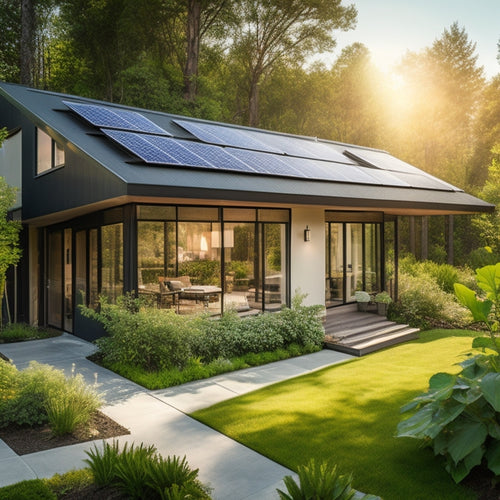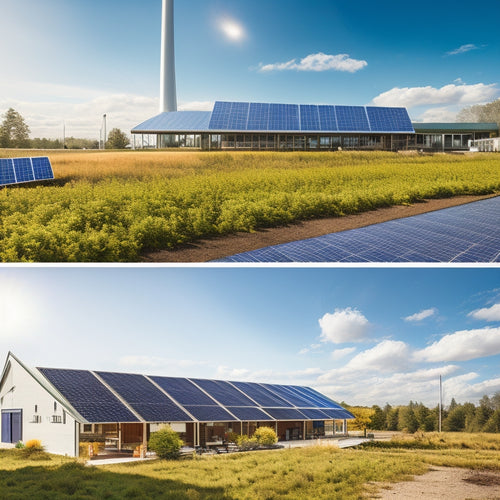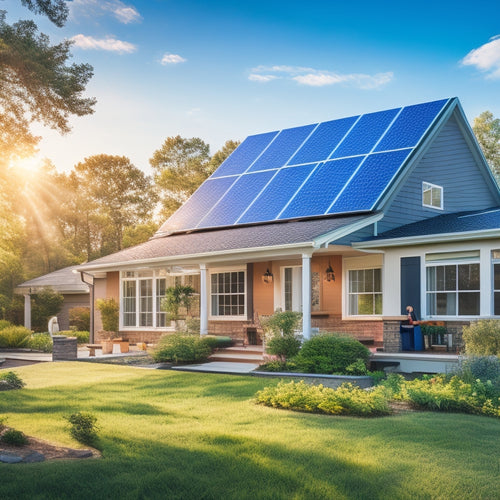
Industrial Facilities Can Save Big With Renewable Energy
Share
By integrating renewable energy systems, you can break free from reliance on the grid, slashing your energy costs and exposure to market fluctuations while gaining control over your facility's energy future. You'll reduce your carbon footprint, enjoy predictable energy costs, and benefit from minimal system maintenance. Plus, you'll position your facility for long-term financial gains and increased property values. By making the switch, you'll not only minimize your environmental impact but also reap significant financial rewards - and that's just the beginning of your renewable energy journey.
Key Takeaways
• Industrial facilities can reduce energy dependence on the grid by integrating renewable energy systems, gaining control over energy costs.
• Renewable energy adoption can lead to notable reductions in energy costs, lower operating expenses, and enhanced profit margins.
• Solar panel system installation benefits include reduced energy costs, decreased carbon footprint, and predictable energy costs with minimal system maintenance.
• Government incentives, such as tax credits and grant funding, can reduce upfront costs of solar installation and minimize financial burden.
• Long-term financial gains are guaranteed with stable and predictable energy cost structures, optimized financial forecasting, and increased property values through solar integration.
Reducing Energy Dependence on Grid
By integrating renewable energy systems, industrial facilities can greatly reduce their energy dependence on the grid, freeing up resources and minimizing the risks associated with price volatility.
You'll have more control over your energy costs and reduce your exposure to market fluctuations.
With energy storage solutions, you can store excess energy generated by your renewable systems and use it when needed, further reducing your reliance on the grid. This increases grid resilience, ensuring your operations remain stable even during outages or natural disasters.
Solar Panel System Installation Benefits
In addition to the installation of a solar panel system, you can expect a significant reduction in your energy costs and a substantial decrease in your carbon footprint. This is because solar energy is a clean and renewable source of power, reducing your reliance on the grid.
With a solar panel system, you'll enjoy predictable energy costs, shielding you from rising electricity rates. Furthermore, you'll benefit from minimal system maintenance, as solar panels have no moving parts and are designed to last for decades.
Additionally, integrating energy storage solutions, such as batteries, can provide backup power during outages, ensuring your operations remain uninterrupted. By harnessing the power of the sun, you'll be in control of your energy needs, reducing your environmental impact and improving your bottom line.
Cost Savings Through Renewable Energy
As you consider integrating renewable energy into your industrial facility, you'll likely be interested in the cost benefits. By leveraging renewable energy sources, you can notably reduce your energy costs, leading to lower operating expenses and increased profit margins.
Energy Cost Reduction
Implementing renewable energy systems can significantly decrease your energy costs, enabling you to allocate more resources to core business operations. Conducting an energy audit helps identify areas for improvement, allowing you to optimize your energy usage and reduce waste. By investing in fuel-efficient technologies, you can further minimize your energy expenditures. Here's a breakdown of potential energy cost reductions through renewable energy:
| Renewable Energy Source | Energy Cost Reduction | Payback Period
| Solar PV | 20-30% | 5-7 years
| Wind Turbines | 25-40% | 6-10 years
| Geothermal | 30-50% | 7-12 years
| Biomass | 15-25% | 4-8 years
| Hydroelectric | 40-60% | 8-15 years
Lower Operating Expenses
By integrating renewable energy systems into your industrial facility, you can greatly lower operating expenses and free up resources for strategic investments.
Conducting an energy audit helps identify areas of inefficiency, allowing you to implement cost controls and optimize your energy usage.
Through budget analysis and expense tracking, you can pinpoint opportunities to reduce waste and allocate resources more effectively.
By incorporating renewable energy into your financial planning, you can stabilize your energy costs and make more accurate predictions about your expenses.
This enables you to make informed decisions about investments and resource allocation, ultimately giving you more control over your facility's financial performance.
Increased Profit Margins
You can greatly enhance your profit margins by leveraging the cost savings that come with renewable energy, as the reduced energy expenses directly translate to increased profitability. By adopting renewable energy, you can redirect funds previously allocated to energy costs towards investments that drive revenue growth and improve your business strategy.
| Renewable Energy Benefit | Financial Impact |
|---|---|
| Reduced energy expenses | Increased profitability |
| Lower operating costs | Improved profit projections |
| Enhanced market competitiveness | Increased revenue growth |
| Improved brand reputation | Increased customer loyalty |
| Compliance with regulations | Reduced risk of non-compliance |
Environmental Impact of Industrial Facilities
Recognizing the environmental implications of your operations and considering sustainable alternatives to mitigate these effects is crucial.
Industrial facilities, which consume vast amounts of energy and resources, are significant contributors to environmental degradation, generating massive amounts of greenhouse gas emissions, toxic waste, and pollution. You're likely aware that your facility's operations have a substantial impact on the environment.
Air pollution from fossil fuel combustion and industrial processes affects local air quality, while water contamination from chemical runoff and waste disposal threatens aquatic ecosystems. Land degradation from mining, drilling, and construction activities further exacerbates the issue.
Climate change, ecosystem disruption, and resource depletion are all consequences of industrial activities.
Government Incentives for Solar Adoption
Government agencies worldwide offer attractive incentives to encourage the adoption of solar energy in industrial facilities, recognizing the need to reduce greenhouse gas emissions and mitigate climate change.
You can take advantage of tax credits, grant funding, and policy reforms that support the shift to renewable energy. Federal initiatives, state subsidies, and local rebates can markedly reduce the upfront costs of solar installation.
Additionally, net metering policies allow you to generate your own electricity and export any excess to the grid, offsetting your energy bills. By leveraging these incentives, you can minimize the financial burden of adopting solar energy and maximize your returns on investment.
Long-Term Financial Gains Guaranteed
Beyond the immediate benefits of government incentives, adopting solar energy in industrial facilities guarantees long-term financial gains through reduced energy expenditure and increased property values.
You can reap these benefits by integrating solar power into your facility's energy mix, ensuring a stable and predictable energy cost structure.
Effective risk management strategies can be developed to mitigate potential risks and maximize returns.
By adopting a long-term investment strategy, you can optimize financial forecasting and asset valuation, leading to a higher return on investment.
A thorough return analysis will reveal the significant financial gains achievable through solar adoption, making it a smart business decision for industrial facilities.
Frequently Asked Questions
Can Renewable Energy Systems Be Integrated With Existing Infrastructure?
You can integrate renewable energy systems with existing infrastructure by ensuring infrastructure compatibility and system harmonization, which involves evaluating and adapting your current setup to accommodate the new energy source's requirements and output.
How Often Do Solar Panels Need to Be Cleaned and Maintained?
You should clean your solar panels every 6-12 months to prevent dust accumulation, which can lead to panel degradation, reducing energy output by up to 25%; regular maintenance guarantees peak performance.
Are Energy Storage Systems Necessary for Industrial Facilities?
You might think energy storage systems are essential, but they're vital for ensuring facility reliability. Without them, you'll face inconsistent energy supply, leading to increased energy costs and potential downtime.
Can Renewable Energy Systems Be Scaled up or Down as Needed?
You can scale renewable energy systems up or down as needed, thanks to energy flexibility and scalable systems that allow you to adjust power output to match your changing energy demands.
Do Renewable Energy Systems Require Specialized Technical Expertise?
You'll likely need specialized technical expertise to design, install, and maintain renewable energy systems, requiring technical training to bridge the expertise gap, ensuring peak performance and minimizing downtime.
Related Posts
-

Integrating Solar Panels Into Home Design
Integrating solar panels into your home design greatly enhances energy efficiency and lowers utility bills while addi...
-

Off-Grid Solar Solutions for Eco-Conscious Businesses
Off-grid solar solutions offer you a path to both sustainability and substantial cost savings. By adopting these syst...
-

Solar Energy Grants and Incentives for Homeowners
Maneuvering solar energy grants and incentives is essential for reducing your installation costs. You can benefit fro...


